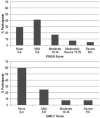Anxiety and depression on an acute respiratory ward
- PMID: 27508081
- PMCID: PMC4964151
- DOI: 10.1177/2050312116659604
Anxiety and depression on an acute respiratory ward
Abstract
Objectives: Psychological difficulties are a common complication among patients with respiratory disease, and are associated with poorer health outcomes and increased use of healthcare. As prevalence studies typically sample patients from community settings, this study aimed to explore the extent and nature of psychological difficulties during acute hospital admission.
Methods: A case example of an acute respiratory ward is presented. In total, 41 acute respiratory inpatients completed standardised measures of depression, anxiety, and health anxiety.
Results: Rates of clinically significant depression, anxiety, and health anxiety were 71%, 40%, and 21%, respectively, with 76% of participants showing clinically significant scores on at least one measure. Comparison to existing literature suggests depression rates may be elevated in the acute inpatient context. The difficulties experienced encompassed both contextual factors related to being in hospital and broader health concerns.
Conclusion: We suggest that psychological distress may be particularly prevalent in inpatient settings and that larger-scale studies are warranted.
Keywords: Respiratory disease; anxiety; depression; health anxiety; inpatient; prevalence.
Conflict of interest statement
Figures
References
-
- Hallas C, Howard C, Wray J. Understanding panic disorder in chronic respiratory disease. Br J Nurs 2009; 18: 527–529. - PubMed
-
- Atlantis E, Fahey P, Cochrane B, et al. Bidirectional associations between clinically relevant depression or anxiety and COPD: a systematic review and meta-analysis. Chest 2013; 144: 766–777. - PubMed
LinkOut - more resources
Full Text Sources
Other Literature Sources
Research Materials


